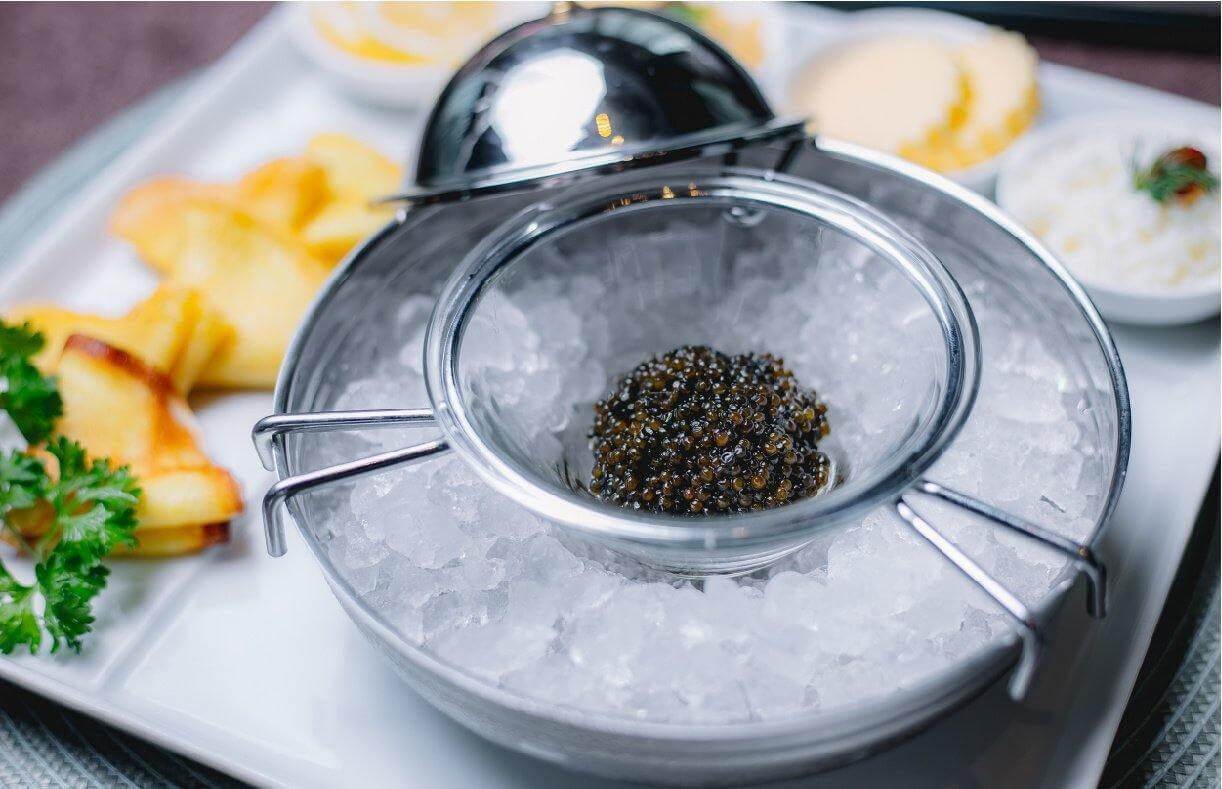
Serve caviar in style
Serve caviar in style | How to serve caviar properly
Caviar is often described as a true fish gem, prized by gourmets around the world and valued as close to gold as possible. For many, it is a symbol of whimsy, for others, it is a matter of refined taste.
Do you know how to properly serve this delicacy?
In practice, there are two schools of thought on how to properly serve caviar .
The advocates of the first school are convinced that the only correct way is to spread the caviar on thin toasted bread previously coated with salted butter. They say that only in this way can we reveal the delicate taste of caviar and enjoy it properly. Anything that could overpower the taste of caviar, such as onions, whipped cream or other ingredients, is simply not allowed. Some of them would approve of a few drops of lemon juice, others not even that. The choice of drinks, on the other hand, is easier. It is limited to ice-cold vodka or a glass of equally well-chilled champagne.
The second school of caviar lovers takes a slightly different approach – the typical American approach. You can mix anything with anything, and everything goes with everything.

Basic rules
Regardless of how you consume caviar, there are a few basic rules to follow. By following them, you will not only enjoy caviar perfectly, but you will also avoid social faux pas and your guests will thank you for an unforgettable gourmet experience.
Storage
Fresh caviar must be stored at a constant temperature of approximately -2°C to +2°C. Under these conditions, it can be kept for 8 to 10 weeks. Under no circumstances should its temperature fall below -4°C, otherwise the taste and appearance will be significantly impaired. If you store caviar in the refrigerator, place it in the back so that it does not experience excessive temperature fluctuations when the door is opened.
Opened caviar must be consumed within one week. Before closing the can, place cling film directly on the caviar. This will prevent it from becoming watery.
Proper serving and eating utensils
Connoisseurs and gourmets consider eating caviar with silver or metal cutlery to be a mortal sin, as they can oxidize and change the taste of the caviar. It is recommended to eat caviar with a horn or mother-of-pearl spoon. Wooden spoons are also great for scooping. It is best to use glass or wooden containers for serving. Caviar can be served in its original jars on gold or gilded trays .
Remove the caviar from the refrigerator about an hour before serving. Do not open it until just before eating. Traditionally, it is placed on the table in a glass bowl placed in a larger container with crushed ice. However, it must never come into direct contact with ice or water, otherwise the caviar will “ go blind ”.
Side dishes and drinks
As a side dish to caviar, we recommend so-called blinis, thin pancakes made from buckwheat flour, or potatoes boiled in their skins, boiled eggs or lightly buttered toast. Of course, you can also eat caviar on its own. Ice-cold vodka (triple distilled), champagne or dry white wine are suitable for drinking.

Did you know that...
Caviar is very healthy. Each grain consists of almost 30% protein and mineral salts. Calcium, iron, iodine, vitamins A, D and group B make caviar a real health bomb , ideal for losing weight. 100 g of caviar contains only 250 calories, if you avoid side dishes such as sour cream, potatoes or pancakes. A weekly caviar diet may be the most expensive but most effective diet in the world.
True caviar is the salted roe of sturgeon, primarily from the Black Sea, the Sea of Azov, the Arctic Ocean, and the Caspian Sea. The most common species are the Lesser Sturgeon, the Siberian Sturgeon, the Russian Sturgeon, and the Beluga.

Sturgeons with pigment defects (" albinos ") are farmed to produce yellowish-white caviar. This caviar is considered the most expensive food in the world . Only about 12 kg is produced annually.
Depending on the preparation, we distinguish between malosol (slightly salted) and barrel caviar (salt caviar, heavily mixed with salt).
There are four types of sturgeon caviar, named after the species of sturgeon they come from. The most expensive caviar is Beluga caviar.

Beluga comes from the European Sturgeon (Huso huso), also known as Beluga Sturgeon. This caviar is considered the finest and most expensive of the caviar species. It is also the largest, measuring 3.5 mm in diameter. (blue cap; very fine). The roe is light grey to anthracite in colour and has a very thin shell. When scooped with a stick or small spoon, you will hear a faint, crackling sound; the caviar "sings".
Ossietra from Russian Sturgeon or Ossetian caviar has a diameter of 2 mm. Compared to Beluga caviar, it is harder and less sensitive. The grain is silver-gray to black and usually has a golden sheen. (yellow lid, nutty aroma)
Ossietra from Siberian Sturgeon is most commonly farmed in Western Europe. Siberian Sturgeon offers a darker ossietra ranging from anthracite to black and with a spicy aroma, also called Sibirian ossietra or Imperial baeri. Depending on the age of the sturgeon, its grain size is on average 2.2–2.5 mm.
Sevruga are the eggs of the Sevruga sturgeon. They have a very thin shell and a diameter of 2 mm. The eggs tend to be in all shades of grey. (red or orange lid colour; strong and spicy)








